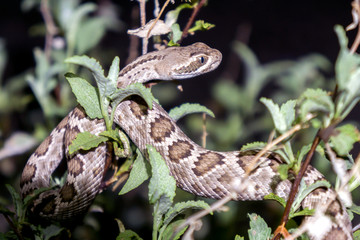ANIMAL: Mojave Rattlesnake Crotalus scutulatus Type of Animal: Viper Habitat: Desert, lower mountainous areas, scrub brush, cactus scrub, Joshua Tree forests/woodlands, plains, plateaus, desert flats, semi-desert grassland, mesquite scrub, desert washes, grasslands, creosote bush flats, open juniper woodland, light chaparral, desert scrub, low valleys, gently sloping bajadas, rolling foothills, creosote bush Location(s): SE California, S Nevada, extreme SW Utah, much of Arizona, far SW New Mexico, & much of N Mexico Appearance: Greenish gray to olive green in higher areas, brownish or yellowish in lower areas, dark diamond pattern along back, white bands on tail wider than black, often mistaken for larger Western Diamondback, which it overlaps w/ in parts of range, young snakes lack rattles Food/Diet: Lizards, kangaroo rats, rats, mice, birds, frogs, bird eggs, insects, other snakes (including smaller members of own species), ground squirrels, rabbits, hares, toads Status in Wild: Stable Conservation: Breeding from zoos, wildlife parks & reptile breeders Lifestyle: Solitary or small groups Additional Info: Called: Male Female Young-Snakelet Group-Den/Rhumba Weight: Male-4 lbs Female-3.5 lbs Gestation: 6-7 months Life Span: 12 years Body Length: Male-2.8 ft Female-2.5 ft Young-10 in Main predators are bobcats, raptors, larger rattlesnakes, kingsnakes, roadrunners, coyotes, & pigs. Females ovoviviparous, in which eggs hatch inside female & she gives birth to 2-24 live young. Females usually give birth from July-September. Most active in late spring & fall, hibernates in winter. Young snakes born fully loaded w/ venom. Usually either nocturnal or crepuscular (active at dawn & dusk). They shake their tail, producing a buzzing sound. They’re usually ambush predators but will also hunt on the move. Like other family members (pit vipers), pits on side of head sense heat. Males perform combat dances w/ each other during breeding season. Fun Fact(s): NEVER TOUCH A DEAD SNAKE-It can still retain venom even if decapitated. Due to widely available antivenom, death uncommon. One of most dangerous snakes in N America due to extremely potent venom & unpredictable temperament. These snakes produce 2 types of venom-type A neurotoxic (unlike other rattlesnakes) affecting respiratory/nervous system, type B hemotoxic (like most rattlesnakes) destroying tissue around bite site. Some individuals have both venom types. Type B 10 times less toxic than Type A.
